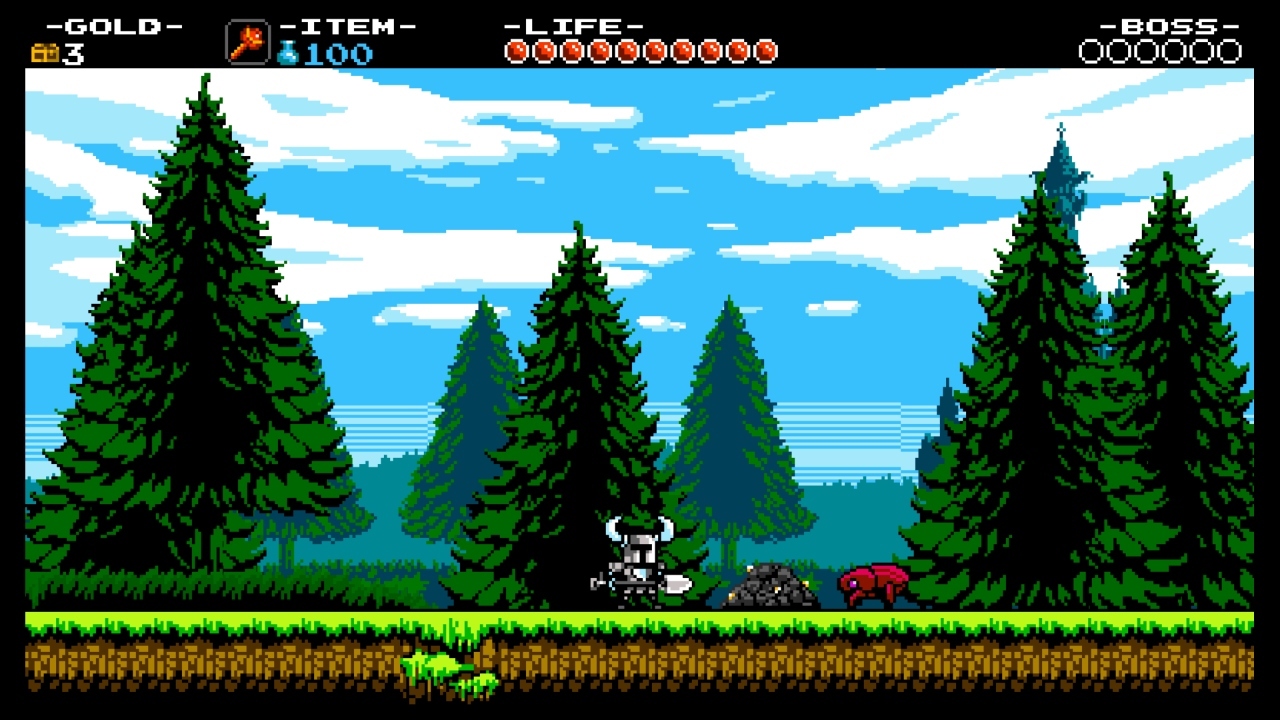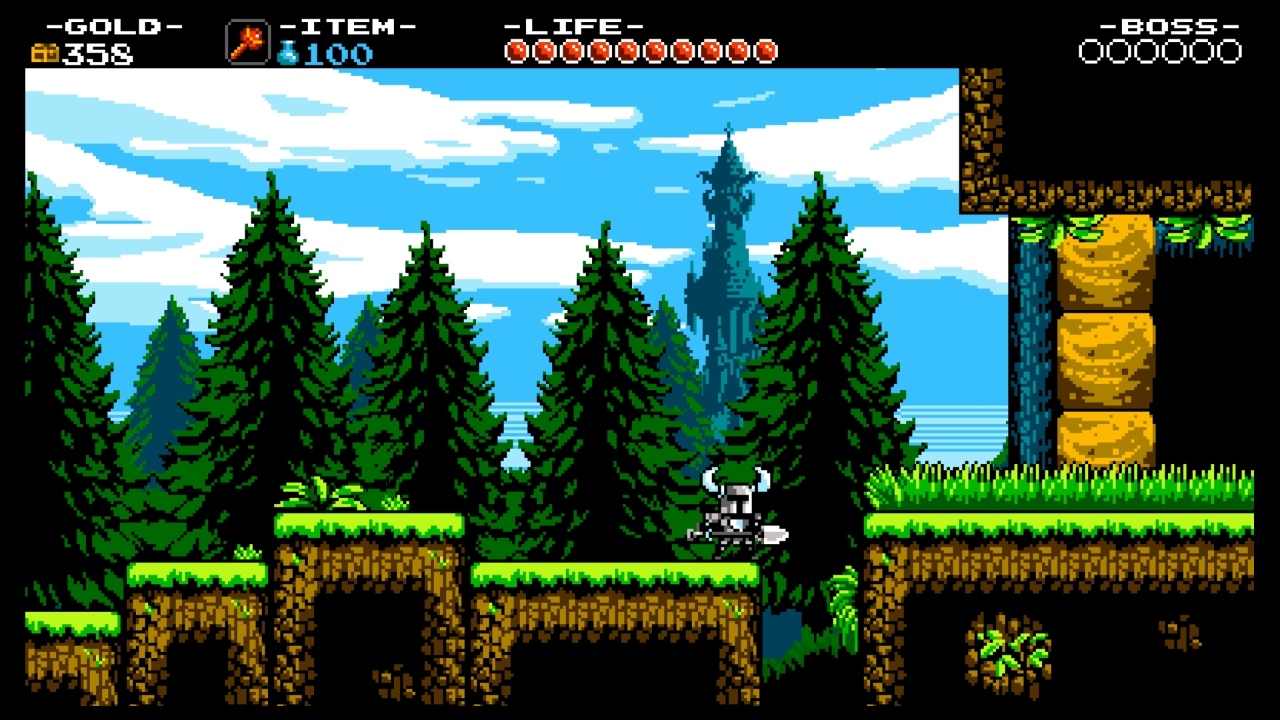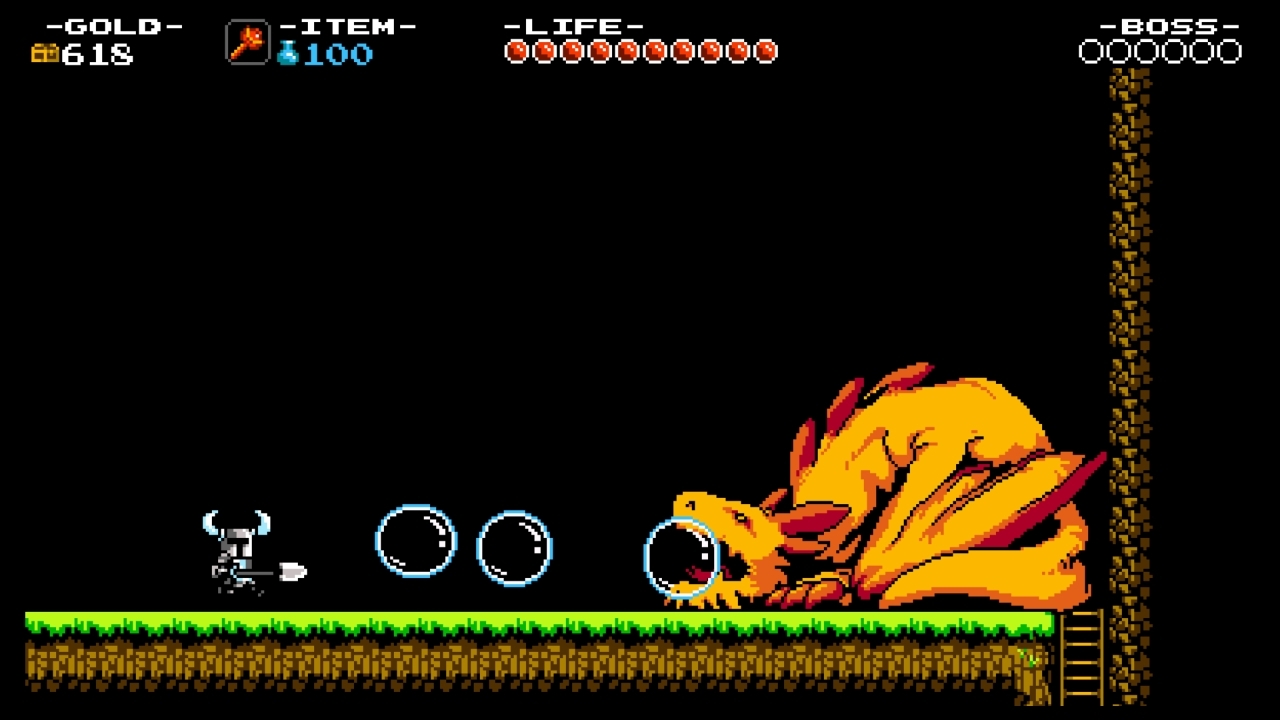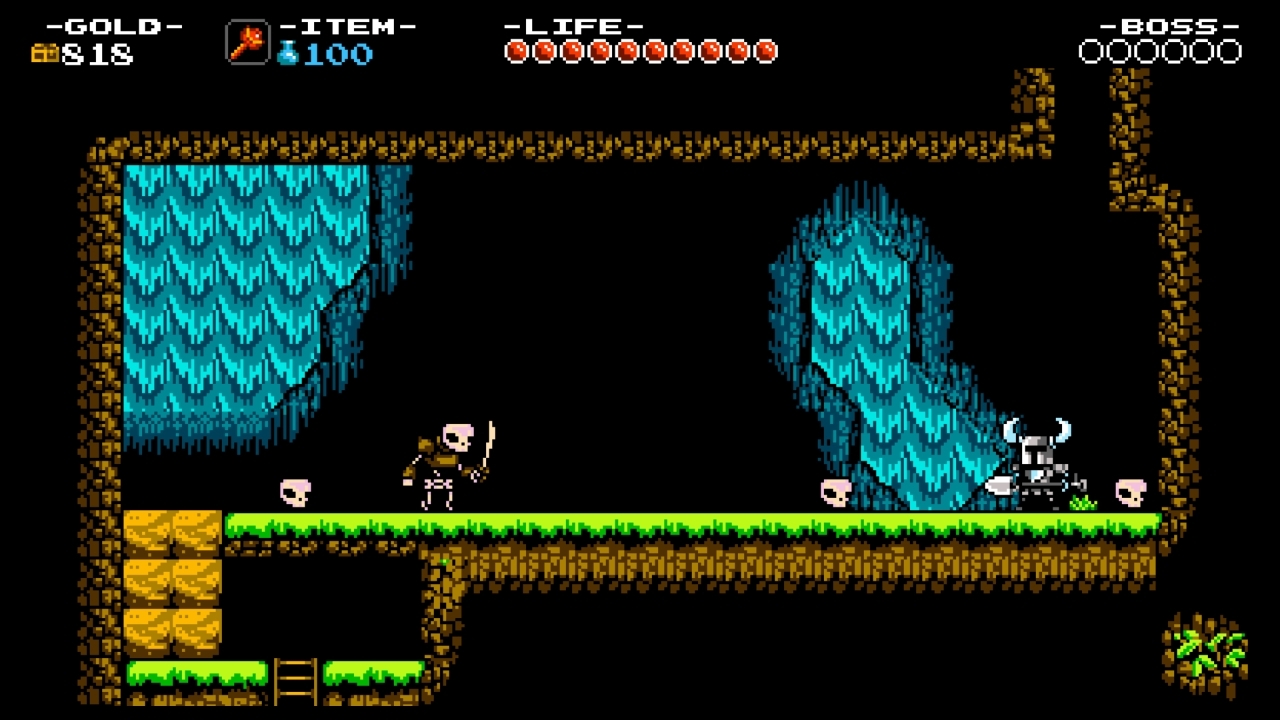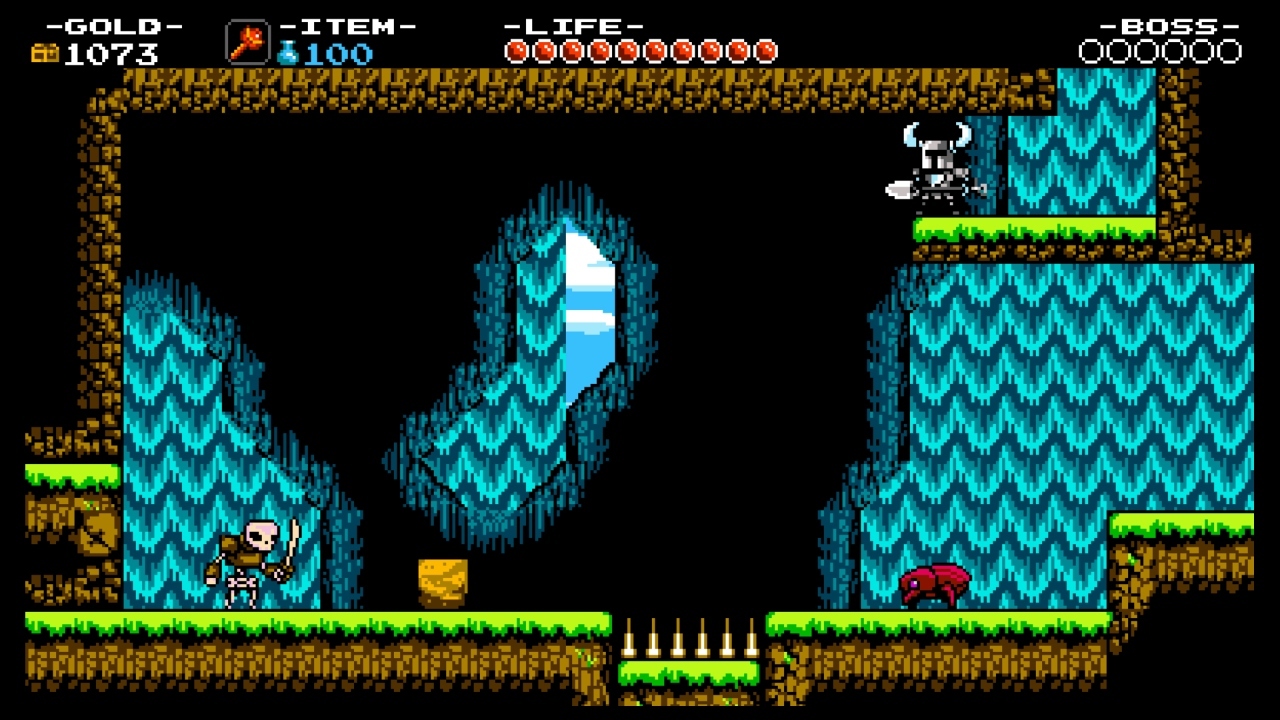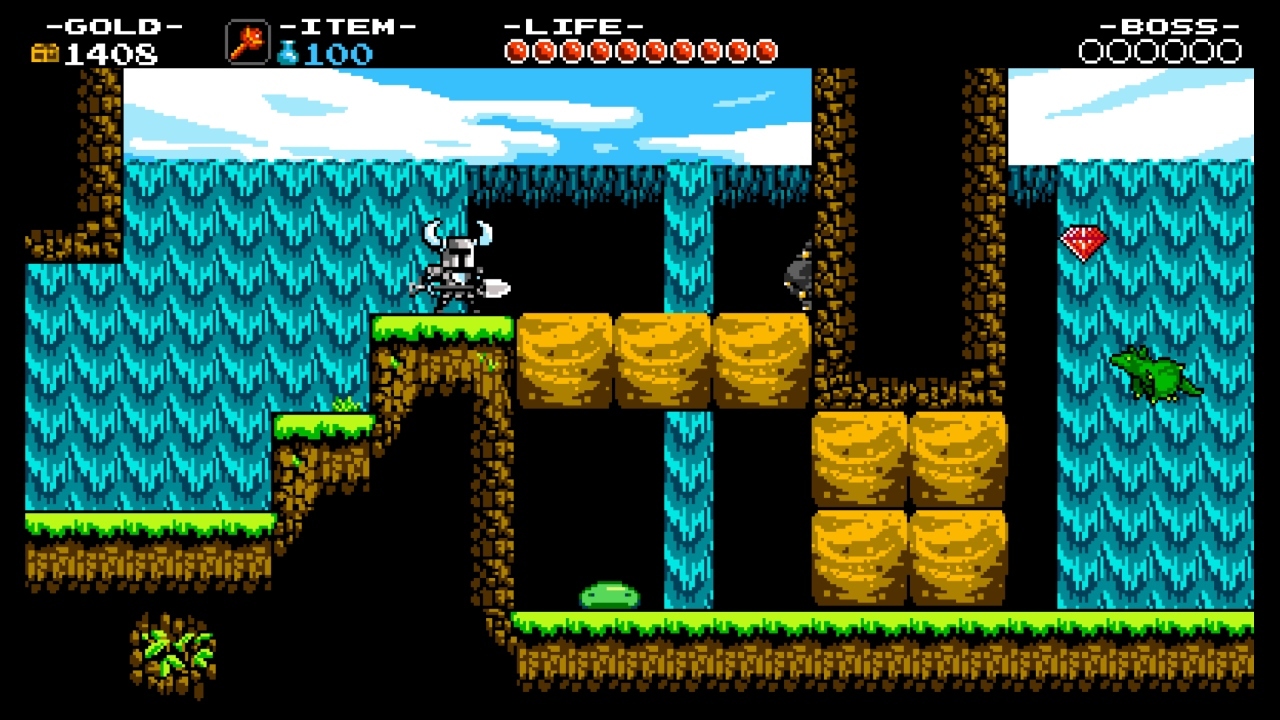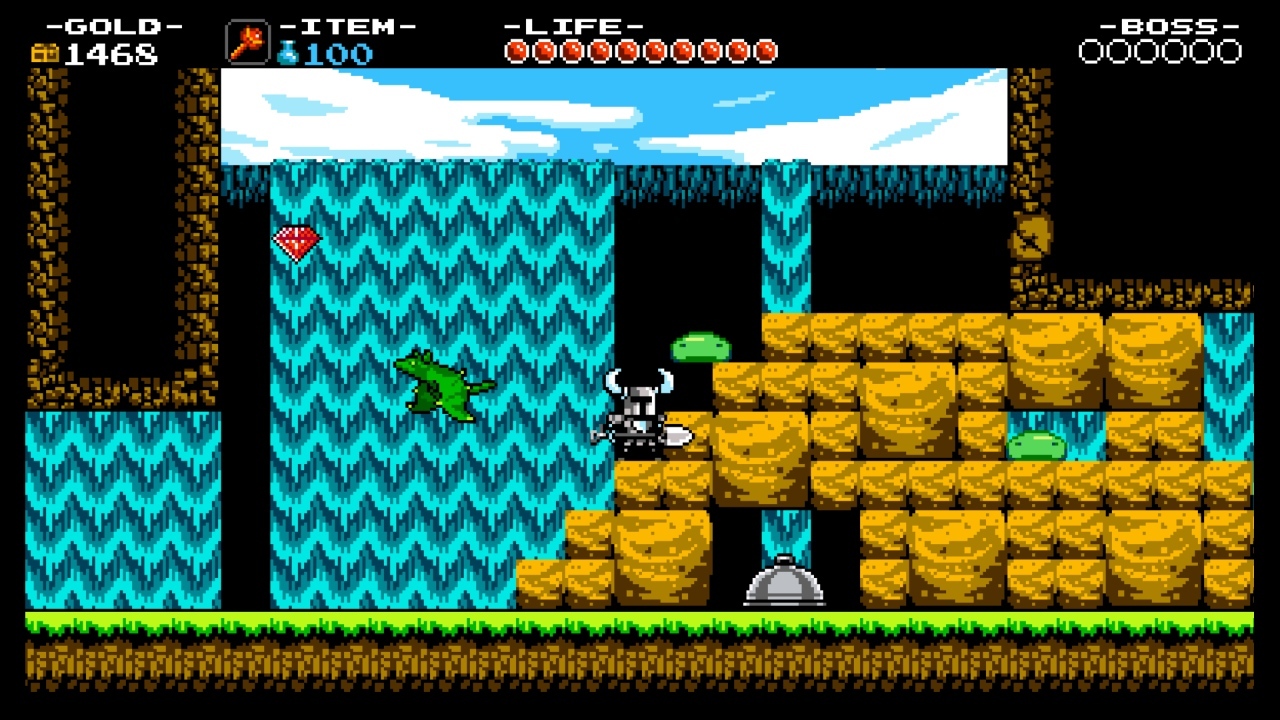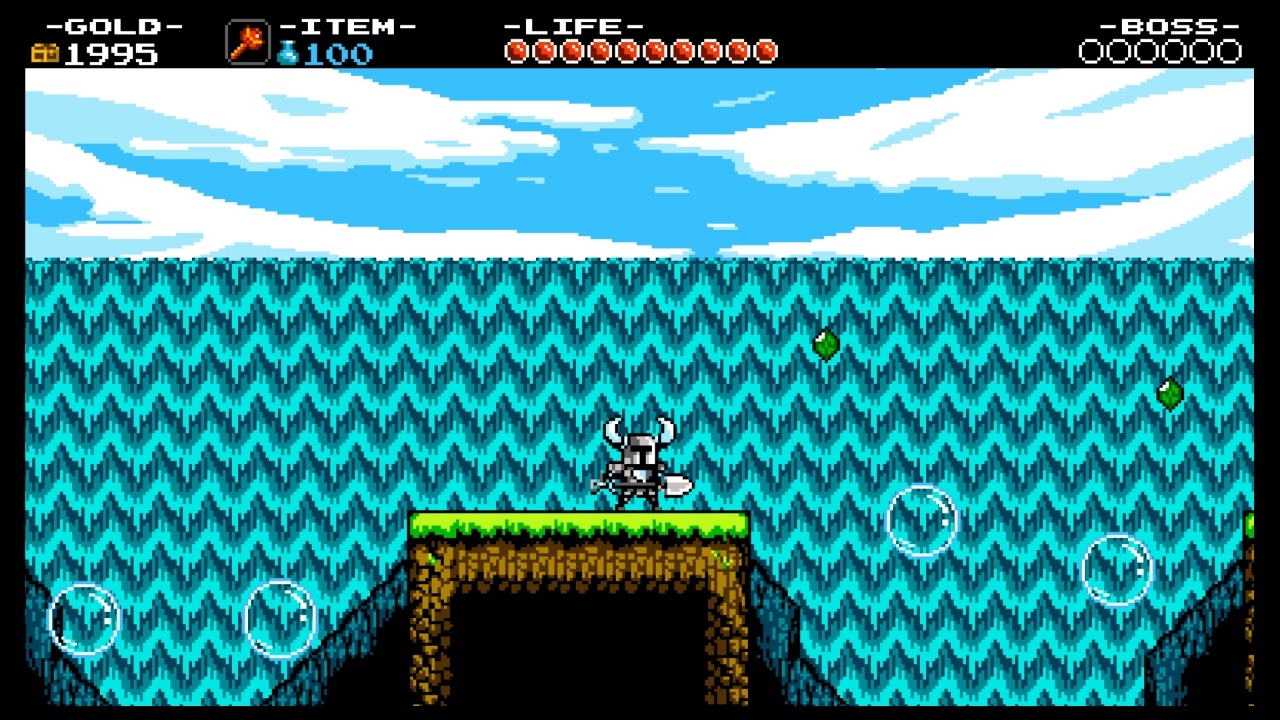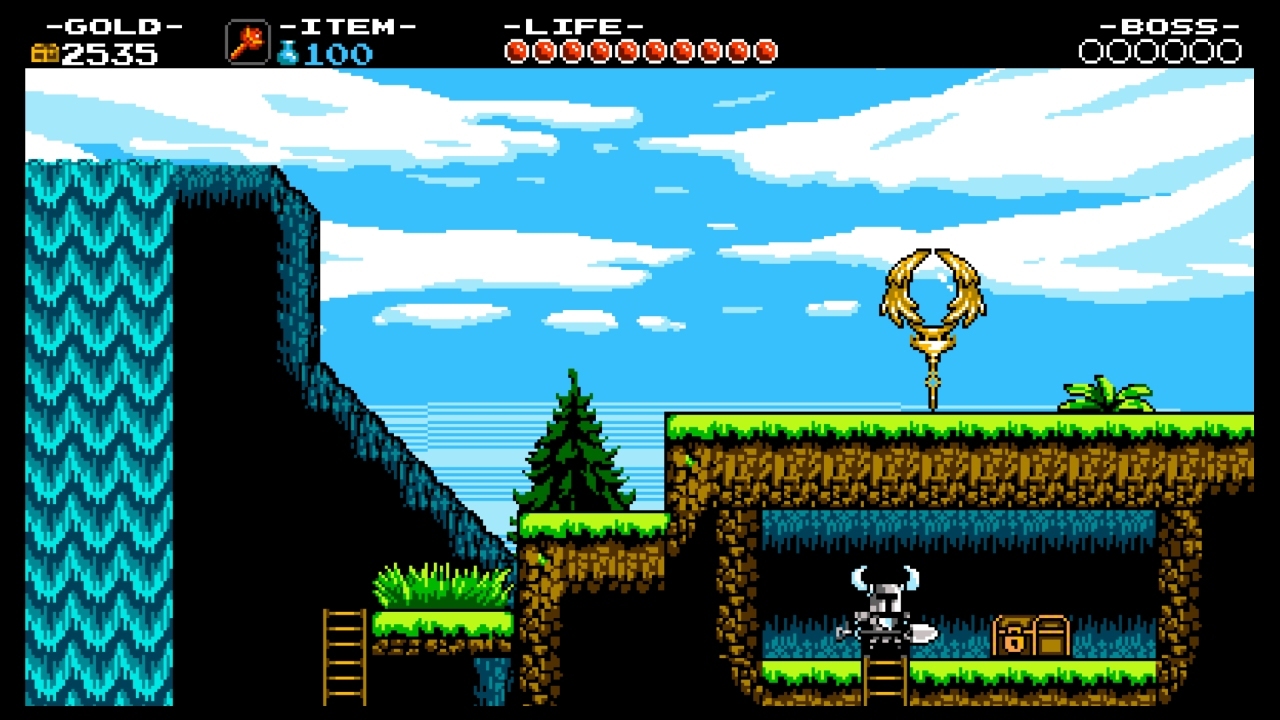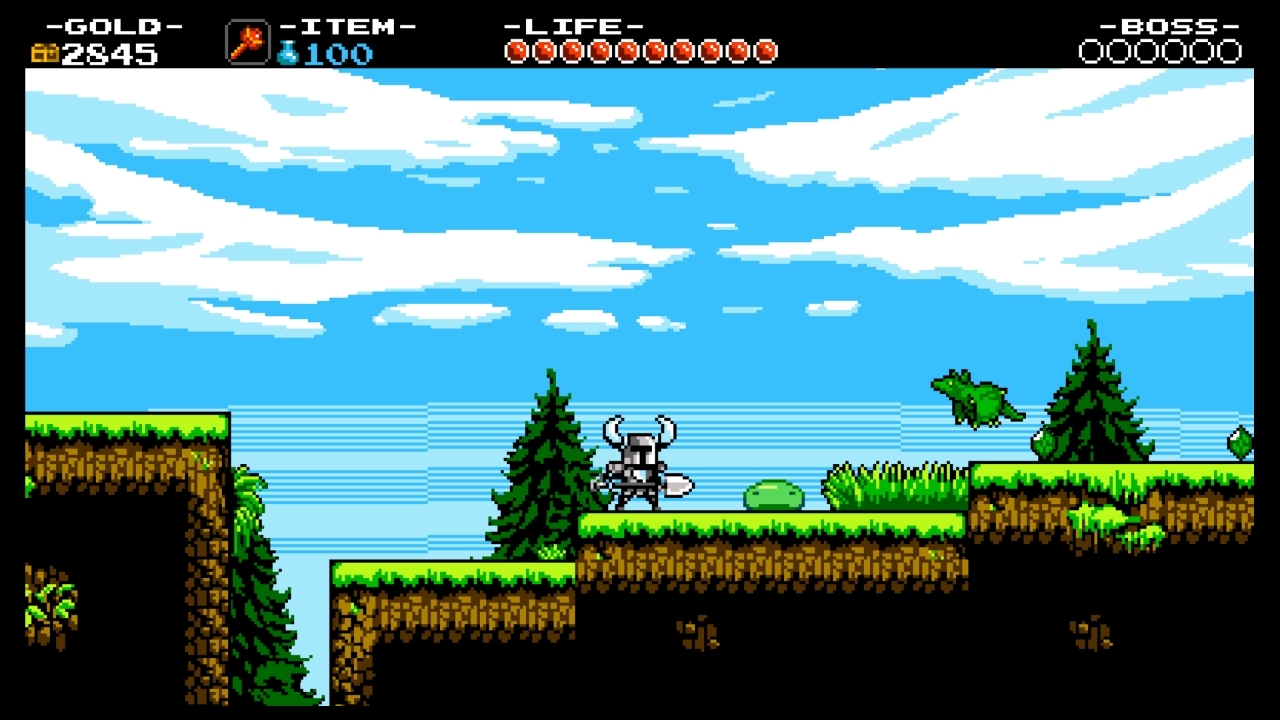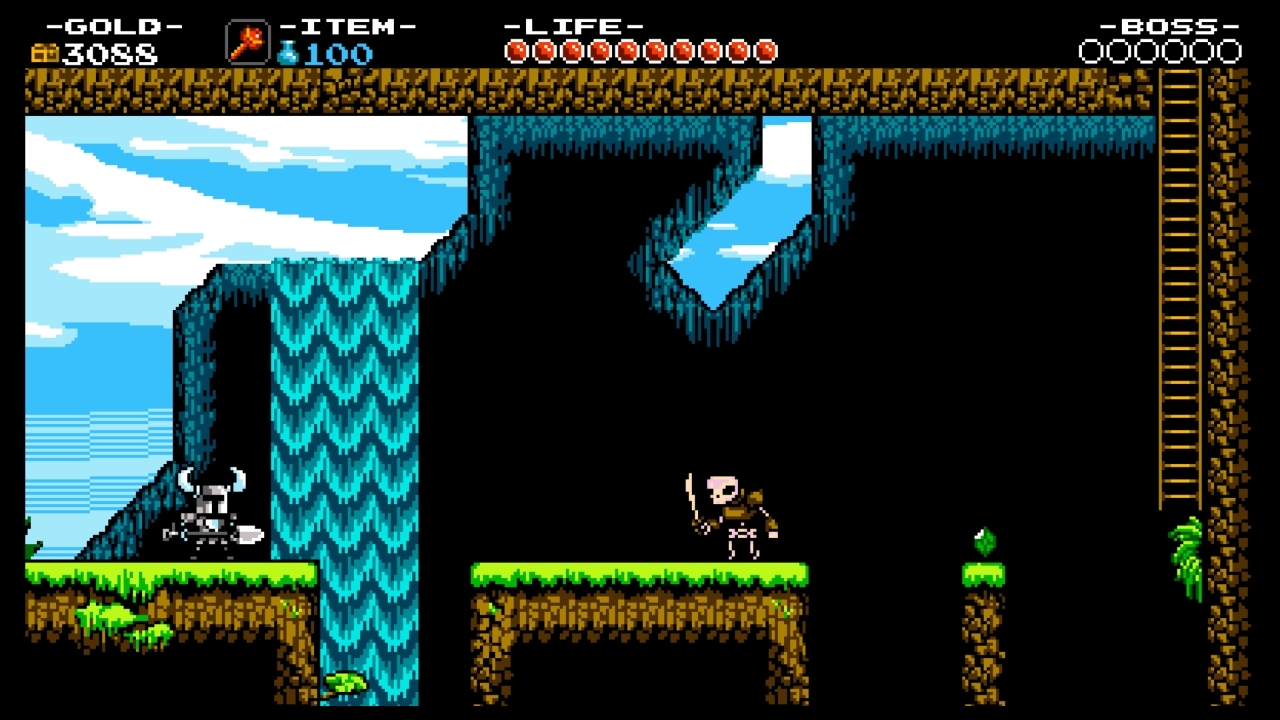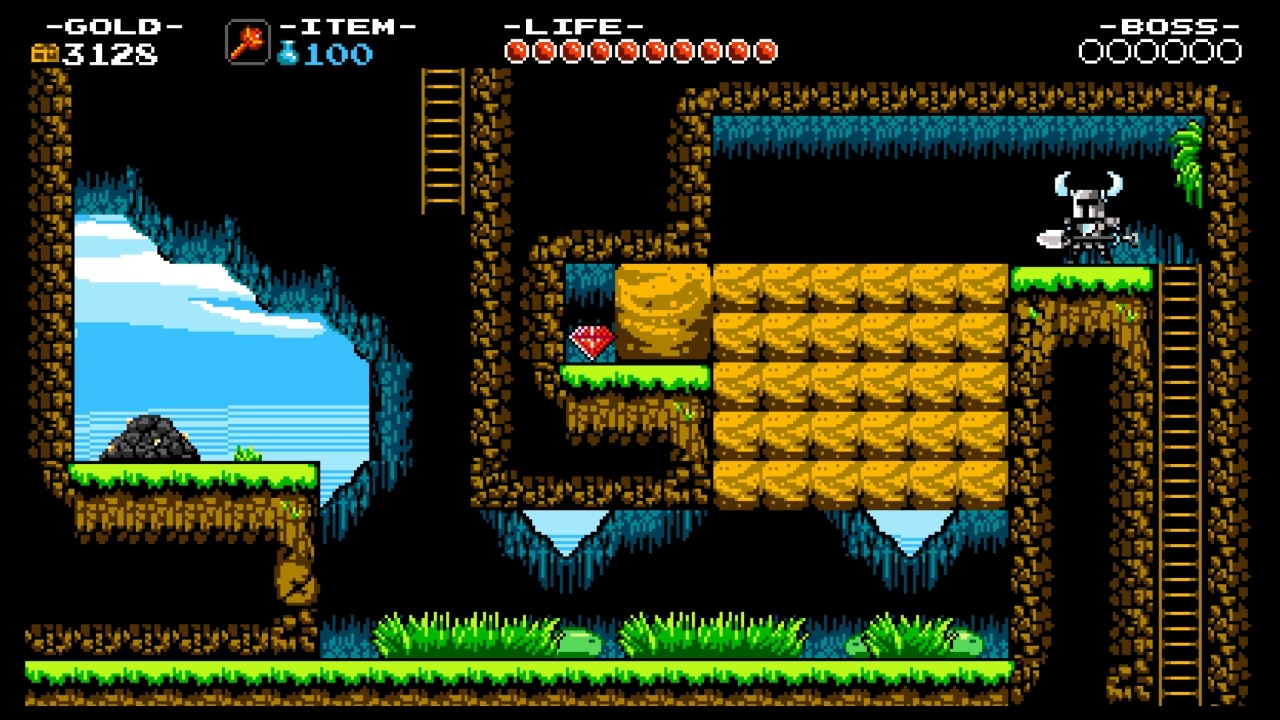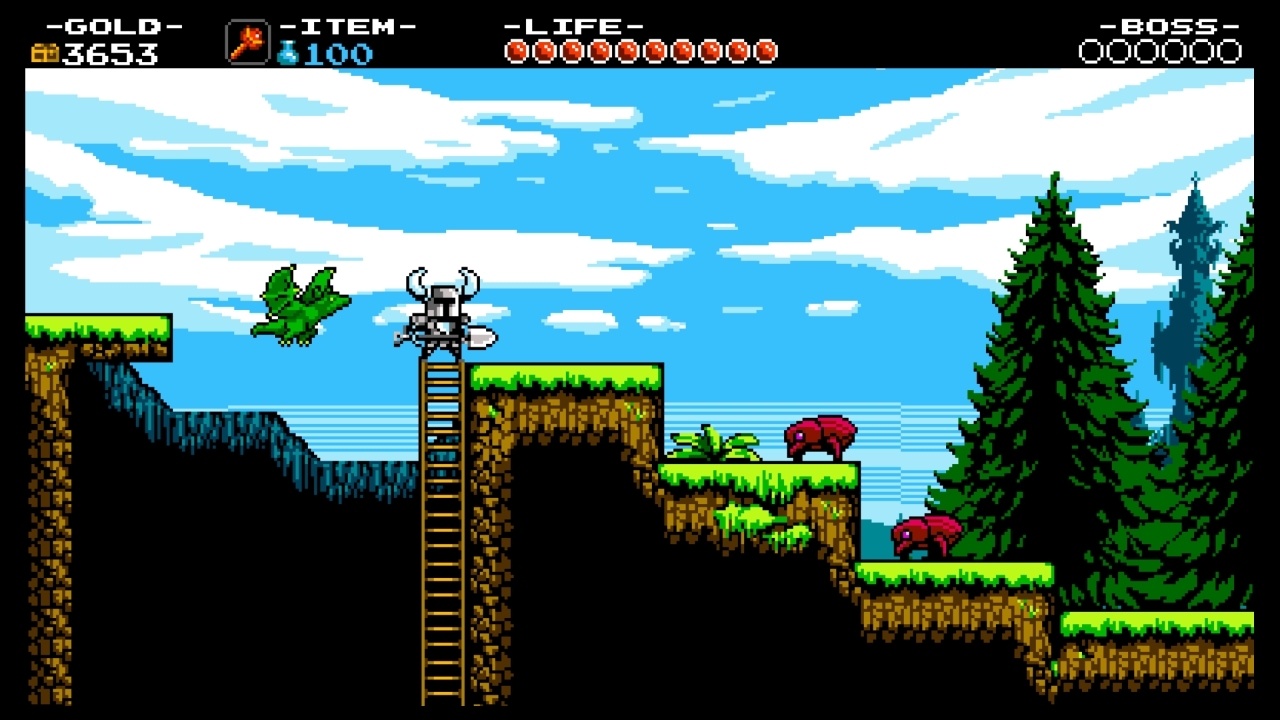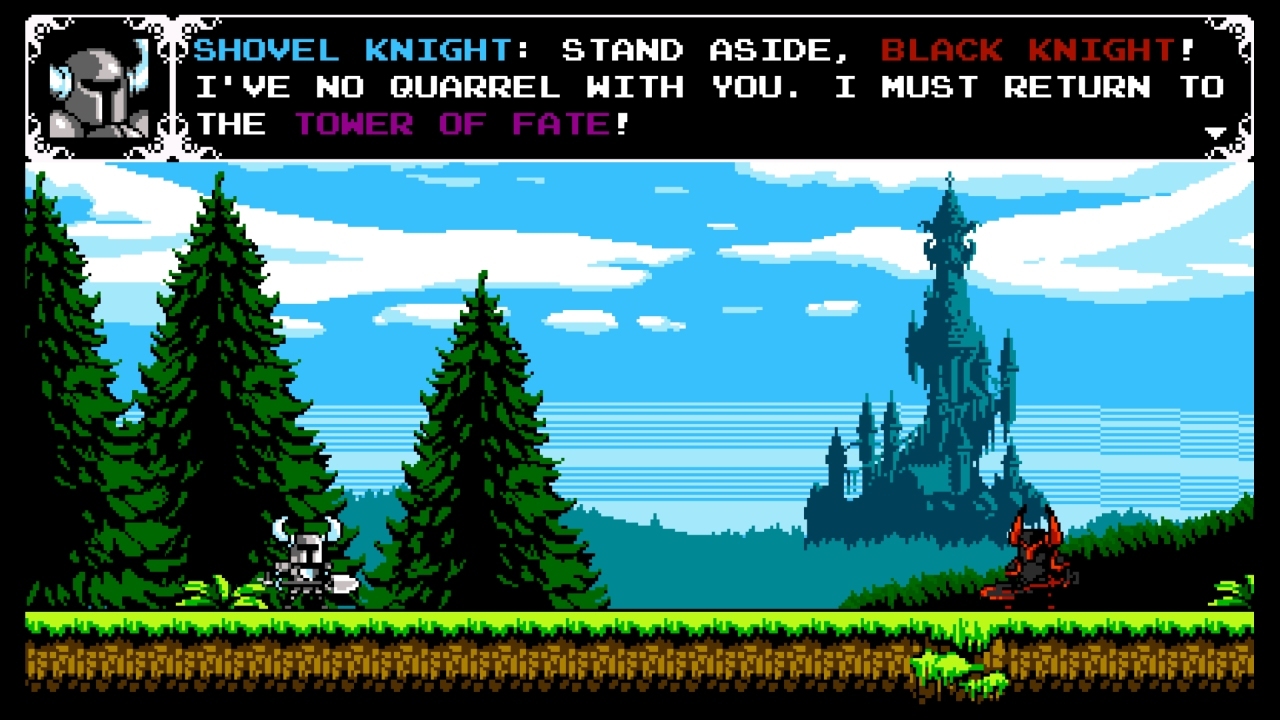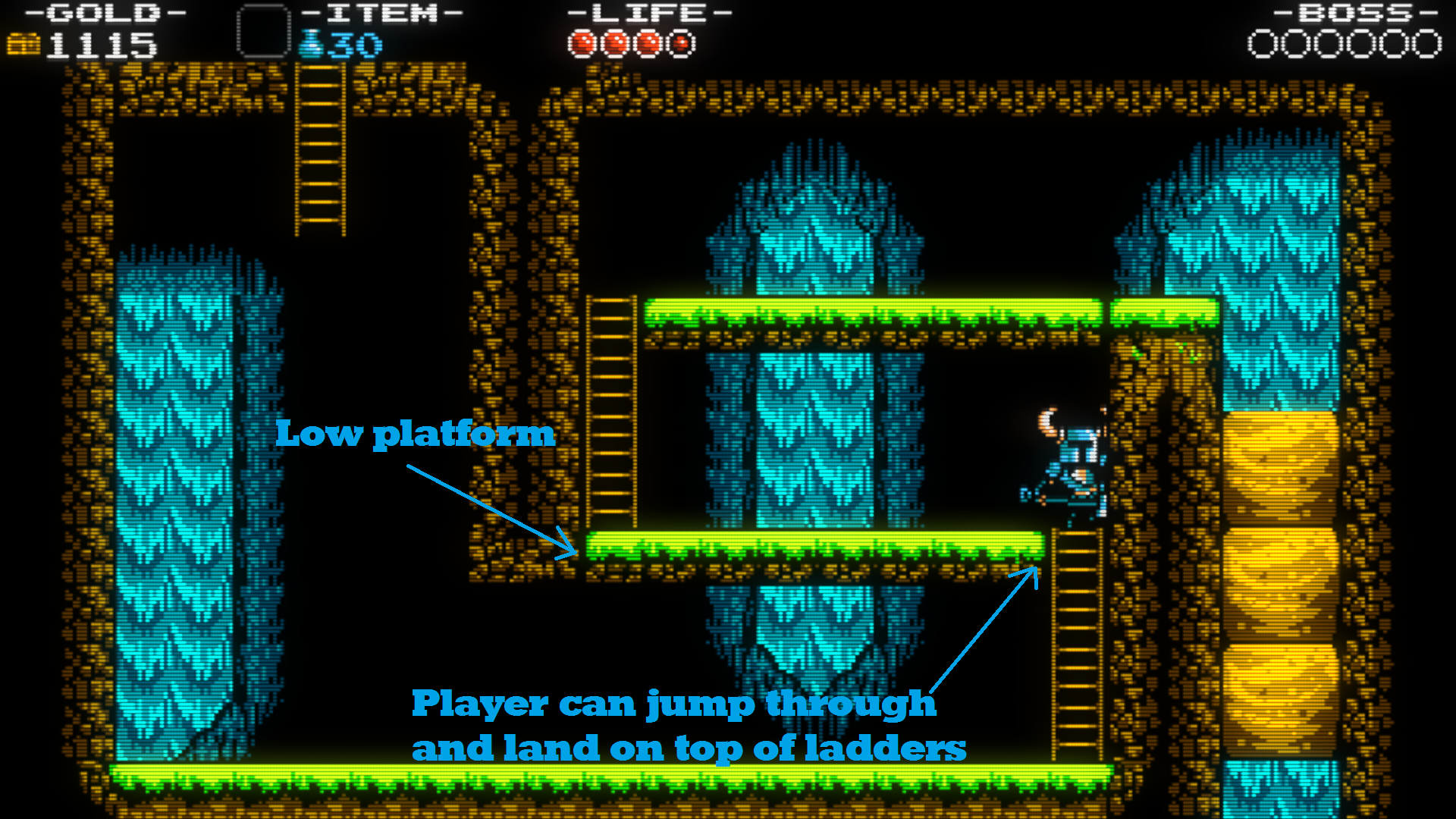Tutorials are a fine art. They're something I find fascinating.
In teaching the basics, so many games lean on crutches like button prompts, pictures or written explanations... But some teach you by letting you play. They arrange the first level so that you learn everything you need to know without the game ever needing to stop the action or break your immersion.
Shovel Knight is a masterful example of such organic design. I like this game so much that I double-dipped on WiiU and 3DS, and may triple-dip on Steam. For the purposes of this tour, all screens are from the WiiU version. Click to enlarge each screen:
Next, the player comes across a chasm, as seen in the second screen. There is only a single bubble between you and the distant ledge. You just learned how to drop with your shovel. Inevitably, the player will try the maneuver on the bubble -- and learn they can bounce off bubbles like they're using a pogo stick, crossing the gap to the other side.
On the next screen, the player encounters another moving platform, this time over a bed of spikes, and a lone piece of treasure to tempt them into falling onto the spikes. If the player lands on the spikes, they will learn that spikes are instant death -- and then they will learn how checkpoints work by respawning at the checkpoint on the previous screen.
Once the player climbs the ladders, they encounter another wall, this time with no imperfection. Another swing reveals another secret passage, establishing that not all secret passages are marked by imperfections in the wall. There are also enemies lying in wait behind the collapsing wall, punishing the player if they rush blindly forward, and underscoring that in Shovel Knight, "haste makes waste."
The player once again drops through sand blocks in the ground and must dodge an enemy below before proceeding to a pyramid of sand blocks. The player can pogo off the flying enemy to reach the treasure in the air. The player can also strike the imperfection in the upper-right of the second screen to reveal more treasure -- provided they haven’t already destroyed the sand blocks needed to reach it. Again, "haste makes waste." Also, here the player finds the first silver platter, containing turkey that will replenish their HP.
Also, note that to cancel your downward shoveling, you need to attack mid-bounce -- something players will also learn while trying to reach the treasure.
And there you have it. The first level of Shovel Knight, and a masterpiece in organic design. I haven't been so smitten with a first level since Super Mario 3D Land. Shovel Knight just gets it, constructing the levels so that new mechanics emerge naturally from the player responding to the layout, and then reinforcing those mechanics with increasingly layered scenarios that also teach through action, rather than prompts or pictures or words.
What do you think of Shovel Knight's approach to tutorials? And what other games also teach the player in an elegant and nonintrusive way?
In teaching the basics, so many games lean on crutches like button prompts, pictures or written explanations... But some teach you by letting you play. They arrange the first level so that you learn everything you need to know without the game ever needing to stop the action or break your immersion.
Shovel Knight is a masterful example of such organic design. I like this game so much that I double-dipped on WiiU and 3DS, and may triple-dip on Steam. For the purposes of this tour, all screens are from the WiiU version. Click to enlarge each screen:
You start off in the wilderness and are immediately faced with two things: A pile of dirt, and a baddie. Right away the game is teaching you that your shovel can be used to dig for treasure, and to whack enemies. I'm reminded of 1-1 in the original Super Mario Bros., where you're immediately confronted with a Goomba. Run into the Goomba, and you learn Goombas hurt you; jump over the Goomba, and you may land on it and learn you can stomp Goombas; jump over it and hit the first brick block, and you'll see you can pop blocks from below. Something similar can happen here, depending on what your spade hits first.
Proceed along and you encounter another dirt pile, another baddie -- and a sand block, a new element. You quickly learn your shovel can destroy sand blocks, as well. Keep moving right and you'll come across your first pitfall and a wall made of sand blocks, as seen in the second screen. The game is teaching you how to jump, and since you know your shovel can break through sand blocks, you know how to get past the wall, as well.
Here's where things start to get interesting. In the first screen, there is a sand block in the ground, but so far you've only been taught how to swing your shovel forward. How do you get through the sand block in the ground to the floor below? Inevitably, the player will jump around, and tap down while jumping -- pile-driving their way into the underground passage.
Next, the player comes across a chasm, as seen in the second screen. There is only a single bubble between you and the distant ledge. You just learned how to drop with your shovel. Inevitably, the player will try the maneuver on the bubble -- and learn they can bounce off bubbles like they're using a pogo stick, crossing the gap to the other side.
Here the player comes across their first checkpoint, their first moving platform, and a string of floating treasure. The platform and the treasure will test the player's precision jumping. The baddie on the upper right will teach the player how enemies can knock you off ledges.
On the next screen, the player encounters another moving platform, this time over a bed of spikes, and a lone piece of treasure to tempt them into falling onto the spikes. If the player lands on the spikes, they will learn that spikes are instant death -- and then they will learn how checkpoints work by respawning at the checkpoint on the previous screen.
Next you encounter a dragon that fires bubbles at you. The player can swing his shovel to pop the bubbles and attack the dragon head-on, but the player will more likely jump and pogo off the bubbles to avoid taking damage. In the process, they will likely end up bouncing off the dragon and dealing damage from above, something that can be done repeatedly. The dragon will inch forward and backwards, and the player can follow, reinforcing the skill of air control.
After the dragon, the player encounters this skeleton. The player also encounters skulls on the ground that they can hit with their shovel to send flying at the skeleton. The game is teaching you that in some cases, you can use the environment against your enemies.
Here the player encounters a seemingly impenetrable wall. Only there is an imperfection in the wall that may encourage a desperation swing -- collapsing the wall, and revealing that imperfections mark secret passages. The nearby pile of treasure can also tempt a swing that might hit the wall instead and reveal the way forward.
Once the player climbs the ladders, they encounter another wall, this time with no imperfection. Another swing reveals another secret passage, establishing that not all secret passages are marked by imperfections in the wall. There are also enemies lying in wait behind the collapsing wall, punishing the player if they rush blindly forward, and underscoring that in Shovel Knight, "haste makes waste."
Here the game presents the player with a choice: Go left and hit the imperfection in the wall to reveal a secret passage, as previously learned, or go right and proceed with the level. The player knows he must jump over the spikes, and he can get the drop on the skeleton by leaping off the sand block and using the shovel drop to defeat the enemy in close quarters. The imperfection in the wall leads to a series of pitfalls the player can then leap across to reach treasure.
The player once again drops through sand blocks in the ground and must dodge an enemy below before proceeding to a pyramid of sand blocks. The player can pogo off the flying enemy to reach the treasure in the air. The player can also strike the imperfection in the upper-right of the second screen to reveal more treasure -- provided they haven’t already destroyed the sand blocks needed to reach it. Again, "haste makes waste." Also, here the player finds the first silver platter, containing turkey that will replenish their HP.
Another checkpoint, another bubble to cross the gap (reinforcing an essential technique), and a baddie timed to knock you down the hole if you aren’t careful. You’re operating without a safety net this time, but the developers placed a checkpoint there for a reason.
These two screens make me think of the "Rule of Three" -- the smallest number needed to establish a pattern, to solidify a concept. They're stringing together multiple platforming concepts established so far -- the moving platform, the moving enemy who can serve as a makeshift platform, the floating treasure to snag with precision... and in the room hidden behind the secret passage, multiple bubbles across which to jump.
What you don't see in the first screen is that the player (yours truly) has revealed two secret passageways -- one above the ledge, one below. Each concealed a skeleton, reinforcing that you shouldn't rush blindly into a collapsing passageway. And the one above wasn't marked -- rather, you think to double back and try hitting the wall once you see the treasure chest underground in the second screen.
Here the player encounters flying enemies that move forward, and here they learn a very subtle lesson, one so subtle most players won't consciously note it: Enemies can hide behind foreground elements such as bushes, as we see with the slime baddies.
Another dragon in another cave, and the complexity has been increased considerably. Not only must the player drop through the sand blocks in the ground, but they must pop the rising bubbles as they do so. And once they hop atop the dragon and start bouncing off its head, they'll have to watch out for the pitfall as the dragon shuffles back and forth across it. This sequence is honing the player's ability to track a moving enemy from the air -- a skill that will be tested again shortly.
A skeleton that stops just short of the edge, risking knockback down a bottomless hole, and a narrow ledge that requires pixel-perfect jumping. By this point the player is well-attuned to the controls -- controls so tight, they're an extension of the mind.
Here, the game once again teaches the player that "haste makes waste." A player who drops their shovel into the sand with reckless abandon will find themselves without a floor to reach the treasure on the left. And if they rush through the grass at the bottom of the screen, they'll run into the baddies that are just barely hidden -- a danger previously established.
Also, note that to cancel your downward shoveling, you need to attack mid-bounce -- something players will also learn while trying to reach the treasure.
As the player approaches the end of the level, bouncing off the flying enemy to go left reveals a series of platforms that require pixel-perfect jumping to reach the treasure on the far side. But again, by this point the player has become one with the controls.
And here's where the air control reinforced in the second dragon battle pays off -- the grand finale against the Black Knight. He'll try to shovel-drop on the player himself, encouraging the player to do the same -- and once the player starts bouncing, they'll think to try and track Black Knight for a second hit as he scurries around the battlefield. And then a third hit... and maybe a fourth. All without ever touching terra firma.
And there you have it. The first level of Shovel Knight, and a masterpiece in organic design. I haven't been so smitten with a first level since Super Mario 3D Land. Shovel Knight just gets it, constructing the levels so that new mechanics emerge naturally from the player responding to the layout, and then reinforcing those mechanics with increasingly layered scenarios that also teach through action, rather than prompts or pictures or words.
What do you think of Shovel Knight's approach to tutorials? And what other games also teach the player in an elegant and nonintrusive way?

